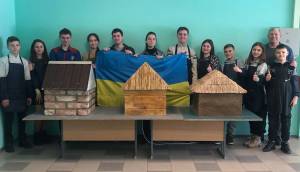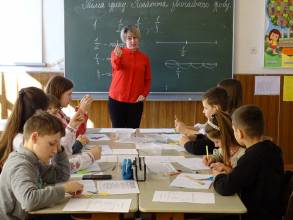Goals
- Support the resilience of Ukrainian school children and raising awareness of their living heritage by developing a resource kit for primary and secondary school teachers on how to integrate living heritage in school-based education in Ukraine.
- Integrate ICH in teaching approaches to demonstrate the role that culture can play in emergency contexts to foster identity, reinforce cultural diversity under threat and facilitate recovery.
- Use education as a channel for communities to transmit their culture as well as to achieve a more inclusive and equitable education in line with the 17 Sustainable Development Goals.
The project builds on the positive results of the joint UNESCO-European Union project ‘Teaching and learning with living heritage’, which was implemented in close cooperation with the network of UNESCO Associated Schools in Europe (ASPnet) from 2020 to 2021. The Resource Kit for Teachers developed as part of this project was translated and adapted to the Ukrainian context, allowing for the methodology to be further replicated to benefit the youth across Ukraine.
The project is being implemented by the Development Centre ‘Democracy through Culture’, a non-governmental organization accredited under the 2003 Convention, in close cooperation with the UNESCO Chair in Scientific Education, the UNESCO Associated Schools Network in Ukraine and other partners. It is supported by the UNESCO Heritage Emergency Fund.
Pilot Projects in Schools across Ukraine
15 primary and secondary schools across Ukraine, including 10 UNESCO Associated Schools, participated in this project to integrate living heritage into core school subjects like mathematics, physics or literature. After receiving the initial training, teachers from the selected schools launched the preparatory works for the pilots. They informed teachers and leadership of their schools, designated teams, and selected living heritage elements to be integrated.
As an example, during a pilot test in the region of Kharkiv, a team of teachers and students from the Krasnokutsky Lyceum worked on integrating the tradition of mazanka (huts made of mud) across several subjects of their curriculum. The team visited nearby villages to observe mazankas dating from the early 20th century. For the physics class, teachers and students built three models of houses in brick, wood and plaster to better understand their isolation characteristics. For chemistry, the students created a chalk mixture to whitewash the plastered houses. As a final activity, the students learnt about the traditional techniques of building mazankas by helping a local community to restore one.
Developing a Resource Kit and Conducting Training of Trainers
The kit being developed (in Ukrainian) under the project will include a step-by-step methodology guidance, case studies from European schools, and new case studies integrating living heritage elements from Ukraine in teaching sciences and other school subjects, as well as short films and other tools for teachers. Teacher training institutions, including the UNESCO Chair in Science Education, would make recommendations on how to include the integration of living heritage in the curricula of teacher training institutions and schools in the longer term.
The training of trainers’ workshop will be conducted on how to integrate living heritage in school-based education and will target about 50 ASPnet teachers, including those who participated in the initial pilot testing. A group of estimated 300+ primary and secondary school teachers will be trained to develop and implement pilot projects in their respective schools. This phase of the project is estimated to reach up to 5000 children in Ukraine.
A dedicated online platform will also be developed to accompany the process and allow the participating teachers to exchange experiences, lesson plans and other teaching tools, and to network and support each other in the implementation of further projects.
Project Outputs
- ‘Teaching and learning with living heritage in Ukraine’ - A Resource kit for teachers in Ukraine on how to integrate living heritage in school-based education
- Training of trainers – for primary and secondary school teachers
- Dedicated online platform for teachers in Ukraine
Impact
This initiative, which brings together UNESCO’s Education, Culture and Science sectors contributes to multiple UNESCO priorities, including improving relevance and quality of education, safeguarding living heritage and making education, including science education, more engaging, while also increasing the learning resources and strengthening the capacities of primary and secondary school teachers and teacher training institutions in Ukraine. , The project will benefit Ukrainian school children, their families and their communities, affected by the war, by strengthening the sense of identity and belonging, reinforcing their resilience and ultimately improving their wellbeing.
At the end of the project, Ukraine will have a network of about 350 trained teachers integrating living heritage in their lesson plans, with a potential reach of about 5000 school children, their families and communities.

© Democracy through culture

© Democracy through culture

© Democracy through culture
See the main page for this project here.
The content of the projects and documents referenced in this platform do not imply the expression of any opinion whatsoever on the part of UNESCO, including designations employed concerning the legal status of any country, territory, city or area or of its authorities or concerning the delimitation of its frontiers or boundaries.
